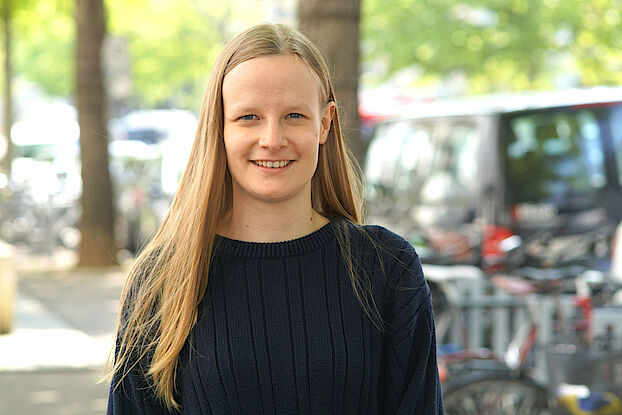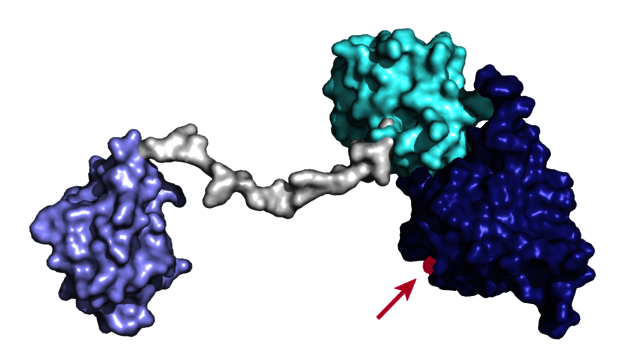/ Preise, SNI INSight
Folding proteins – Anna Leder’s fascination with structural biology

Auch Anna Leder bekommt den Preis für die beste Masterarbeit in Nanowissenschaften in diesem Jahr verliehen. Anna hat in ihrer Arbeit die Struktur eines Proteins aufgeklärt, das eine wesentliche Rolle bei einigen Krankheiten spielt.



In 2021, one of the awards for the two best master’s theses goes to Anna Leder for her paper on the characterization of a helper protein using nuclear magnetic resonance (NMR) spectroscopy. Anna wrote her thesis while working in the research group led by Professor Sebastian Hiller at the University of Basel’s Biozentrum.
In order for proteins to fulfil their manifold tasks in an organism, they must have the appropriate three-dimensional structure. Helper proteins known as chaperones support the processes that result in the proper folding of proteins. The chaperones themselves do not become part of the protein complexes, but ensure that the protein is arranged into the correct tertiary structure.
Understanding on the atomic level
Sebastian Hiller’s group uses nuclear magnetic resonance (NMR) spectroscopy to study these chaperones at the atomic level. This gives the researchers a better understanding of how the chaperones function, and what effect disorders in their activity can have.
For her award-winning master’s thesis, Anna characterized a particular chaperone that supports the formation of disulfide bonds using a combination of NMR spectroscopy, various biophysical methods and crystallography. “I took a close look at the function and structure of the chaperone and examined its functional cycle, which is highly complex: besides supporting protein folding, the chaperone also regulates other chaperones,” Anna explains.
Various mutations in this chaperone have been directly linked to serious illnesses. Accordingly, in order to develop drugs or treatments, it is important to understand the protein in structural and functional terms. “For example, extensive characterization of the protein has helped us to shed light on the molecular basis of a serious liver disease in collaboration with our partners,” the young nanoscientist reports.
Flexibility thanks to the pandemic
If everything had gone according to plan, this project would have been Anna’s first project assignment, which she had planned to follow up with a second in Montreal on the subject of crystallography. Her plans were thrown into disarray by the COVID-19 pandemic, however.
the spring of 2020, when her progress so far would have been enough for a project assignment, there was still hope that a trip to Canada would be possible later in the year. Accordingly, it made sense to continue her work on the helper protein, turn it into a master’s thesis and complete her project assignments subsequently. “I was given fantastic supervision from Dr. Guillaume Mas,” Anna reports. “I was delighted to have the opportunity and support to keep on working on my project throughout the lockdown.”
Unfortunately, as the year progressed it became apparent that the COVID-19 pandemic had ruled out trips abroad for some time, so after completing her master’s thesis Anna stayed on in Hiller’s lab to write a project assignment there too. To this end, she explored ways to study larger protein complexes using NMR by marking individual amino acids.
In the end, Anna was able to wrap up her nanoscience degree with a project abroad after all, writing her second project assignment in early 2021 at the Max Perutz Lab in Vienna (Austria). For this project, she used optical microscopy to ascertain how the message that a cell contains too many unfolded proteins is passed on to the cell nucleus. Her trip was supported by an Argovia travel grant.
“I was utterly astounded by the quality of Anna’s work, performed under the challenging conditions imposed by the first COVID-19 lockdown. Thanks to an appropriate combination of biophysical techniques and experiments, Anna succeeded in revealing the protein’s entire functional cycle in a remarkably short time. Her results are outstanding, and represent substantial progress for the field as a whole.”
Professor Sebastian Hiller, Biozentrum, University of Basel
An interest in structural biology
During her highly varied degree, Anna discovered a particular interest in questions of structural biology, prompting her to choose this field for her doctoral dissertation too. She has not yet decided whether she will complete her doctorate at the University of Basel or elsewhere, however. For the next six months, she will continue working in Sebastian Hiller’s group as an intern, and then decide what comes next.
A broad range of interests and talents
When Anna started studying nanoscience in 2016, at first she wasn’t quite sure whether it was for her. She came to Basel from her hometown of Pontresina to attend a bachelor’s information day and form her own impression. At the time, she was particularly interested in the natural sciences, languages and music, and had not yet decided what to study. Keeping an open mind, she chatted with nanoscience students and attended the presentation of the degree program. “It sounded like a great mix, so I decided to give the nanoscience program a try,” she recalls, adding that the decision has given her no cause for regret.
Like Charlotte, Anna also found the physics challenging, and remembers the block courses as a highlight of the bachelor’s program. These early insights into the practical work being done by different research groups in biology, chemistry and physics were highly motivating, and she thoroughly enjoyed the close connection among students.
“It’s a modestly sized program, so we got to know each other very quickly, forming friendships and always supporting each other,” recalls the 24-year-old from Switzerland, who before winning the award for best master’s thesis had previously been distinguished with a prize for best Matura (school-leaving certificate) at her school, besides winning a “Best Talk Award” at the nanoscience program’s Smalltalk symposium.
Additional information
Research group Sebastian Hiller
Short video with Anna Leder and Charlotte Kress
